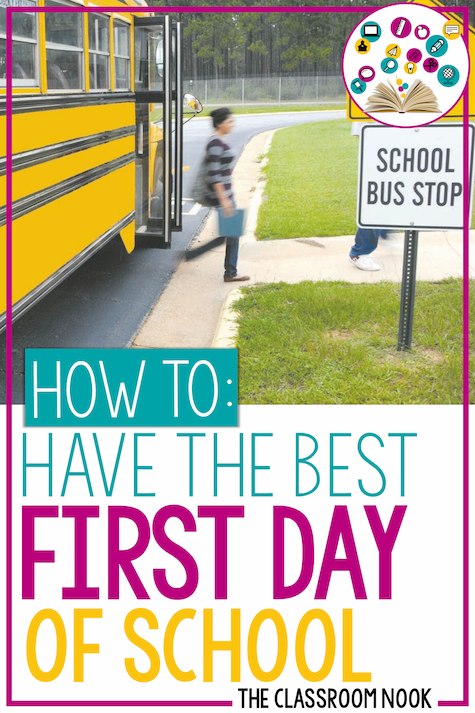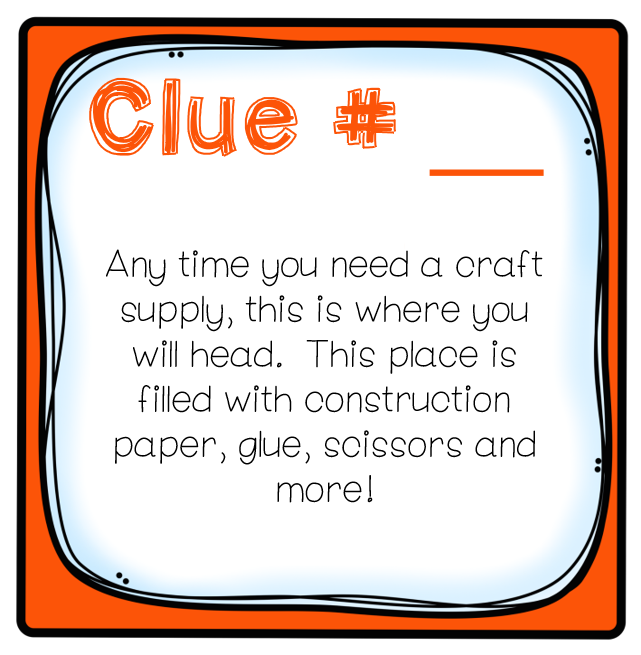How To Have The BEST First Day of School
Love podcasts? Check out this post in the form of a podcast episode on The Classroom Commute Podcast:

The first day of school is typically filled with all kinds of emotions. You're excited to meet your new students, show off your fresh classroom, and dive in to a brand new year.
You're also likely feeling over-whelmed, scatter-brained (feeling like you are forgetting something...), and pressed for time to get it all done before day one.
Setting a positive tone on the first day of school is crucial to setting yourself up for success. Allow me to walk you through your survival guide for having the best first day of school!
CREATE A FIRST DAY OF SCHOOL CHECKLIST:
It's easy to begin thinking way ahead to what your first reading unit might be, or what centers your students will begin with, but it's also important to think specifically about the first day, making sure you've got everything prepped and ready to go. Having a checklist of things that need to be completed specifically for the first day of school will minimize that scatter-brain feeling and help you isolate your thoughts to focus only on day one.
Here are some things that you may want include on your checklist to have completed for the first day of school:
print off class list(s) and schedules
make a list of student copies needed for the first day
make a list of copies needed for papers you will be sending home with students on the first day (emergency forms, parent letter...etc)
write out your lesson plans/activities for the first day
prep ice-breaker games (collect materials, make copies for each activity...etc...)
prep a fun "welcome back" gift for your students
prep an activity for students to complete as they arrive
prep any SMARTBoard/whiteboard/anchor charts you want to have already made for the first day
gather read aloud books that you will use on the first day
prep extra activities that you will have as back-up
WELCOME YOUR STUDENTS WITH A YUMMY TREAT:
Students love to see something special for them on their desk when they arrive on day one. Why not greet them with a yummy treat that they can snack on when working on a welcome activity/craft? You can even do something as simple as stuffing snack-sized bags with goodies and topping with a cute bag topper.
PREPARE A WELCOME ACTIVITY:
The first hour of the first day can be hectic as you greet students and parents. Be sure to have an activity on their desk ready for them to complete as they arrive. This activity should require little direction from you so that they can get started on their own. You may choose to have an example of the activity posted in the front of the classroom for students to refer to, and/or directions posted on a SMARTBoard/whiteboard/chart paper. Have any materials needed (such as crayons, markers, or scissors) readily available for students to use.
An easy activity for students to complete (that also doubles as a great open-house display) is an "All About Me" poster. Students can share fun facts about themselves and learn about their new classmates as well.
PLAN TO TAKE YOUR STUDENTS ON A CLASSROOM TOUR:
Students love entering their new classroom for the first time. They are anxious to learn where they will be sitting, where art supplies are kept, where the gathering area will be, and of COURSE, where the free-time games are kept, among other things. One fun activity that I loved doing with my students on the first day of school, was giving students an opportunity to explore their new classroom through a classroom scavenger hunt.
Students were broken up into teams, and were given clue cards that led them to different sections of the room such as the classroom library, the listening center, supplies cupboard, and more. At each section of the classroom, the teams also collected little goodies that they could then enjoy once the scavenger hunt was completed. They snacked on these treats while we went over the scavenger hunt locations, and I explained more information about each location.
HAVE STUDENTS COMPLETE A FUN WRITING PIECE:
Data collecting is huge in today's classroom. Teachers are always collecting baseline assessments for where students are at in their learning. One fun way to do this right from the start is to give students a writing activity that doesn't feel like "work," but rather more like a game.
I used "Roll & Write" story prompts at the beginning of the year (and all year long in my writing centers - here's a set of prompts to get your started) to get a quick writing sample from my students. Students use a die to roll a character, setting, and plot, and then use those story elements to craft a story. This activity is fun for the students, and gives teachers a good idea of the students' ability to structure a story using these prompts.
Free“roll & Write” writing prompt template
Turn traditional writing prompts into a game with this fun Roll & Write activity. Using this freebie and a simple die, students have endless ideas for their next story!
Put it at your next writing center or use it with your fast finishers for an easy-prep activity!
PLAN A GETTING-TO-KNOW-YOU ACTIVITY:
Students want to know who they will be sharing their classroom with all year. They ALSO don't want to be sitting in their seats all day listening to the teacher talk at them all day. One fun ice-breaker game that I used on the first day is called "Talk & Walk."
It's easy to prep and lets students walk around and meet a lot of new students in a short period of time.
Here's how it works:
Students are each given a card with a "getting to know you question" on it.
Students walk around the room to quickly find a partner to ask their question.
After partners have answered each other's questions, they trade cards and go find a new partner with their new question.
Students can keep going for as long as time allows.
So easy and so fun!
PLAN TO TEACH ROUTINES & PROCEDURES:
Many teachers make the mistake to skip teaching routines and procedures on the first day. They think that doing more "fun" activities will help students feel more welcome and excited about their new teacher and classroom. And while you do want to have a welcoming environment for your students, students actually WANT to feel the sense of structure and process in their classroom. This helps them feel safe in an unfamiliar place. It also sets the expectations that you will hold them to all year long.
YOU MAY LIKE TO READ:: SETTING UP ROUTINES AND PROCEDURES
free routines & procedures checklist
The success of your classroom management system begins and ends with routines and procedures. This FREE checklist will make sure you cover them all!
Plus - the download includes a student sheet for reinforcing those routines and procedures that are most important!
ALWAYS PLAN BACK-UP ACTIVITIES:
I don't have to tell you that teaching in an unpredictable job. Even when you think you've planned your day to a T, there are always interruptions and unexpected things that happen. To ensure you're not left with a classroom full of students and left-over time before the end of the day, have a few extra activities on hand in case you need them.
Simple activities like “Math About Me,” All About Me Cootie Catcher,” and “3-2-1 Get to Know My Teacher,” are easy to pull out if you find yourself with a few extra minutes, or need to keep your class occupied for a few minutes. Find these activities in my First Day of School Survival Kit
YOU MAY LIKE TO READ: 5 (Constructive) Activities to Do When You Have 5 Minutes to Fill
Want some ready-made, print & go activities for your first day of school? Snag my First Day of School Survival Kit HERE! You'll find all the checklists, planning pages, printable resources, games, and more for your first day of school! See all the details by clicking the picture below.












